吴裕雄--天生自然 R语言开发学习:聚类分析
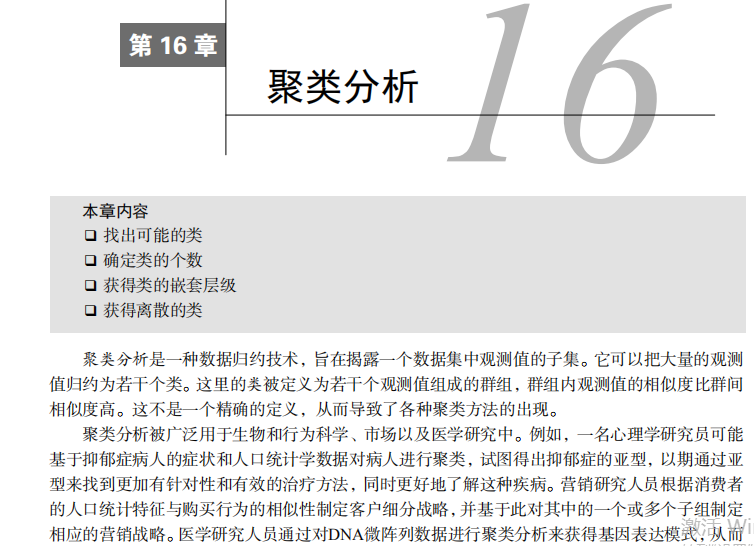
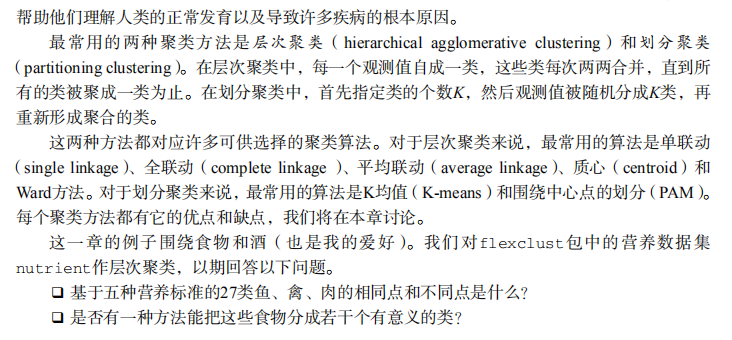
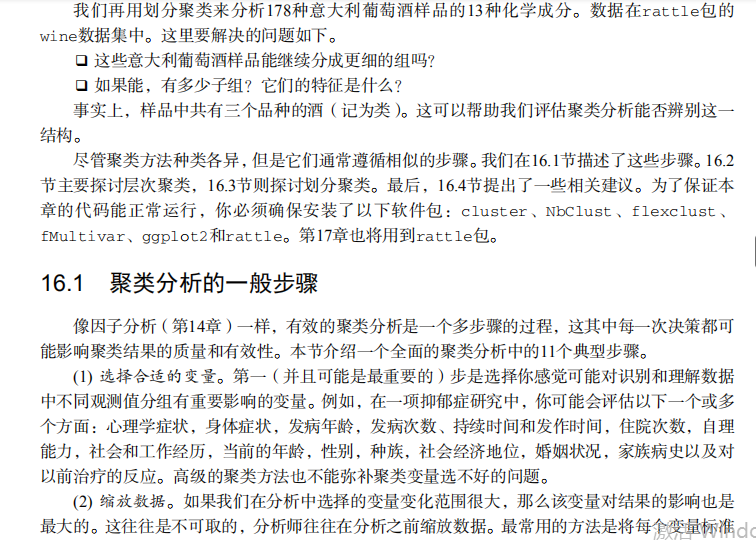
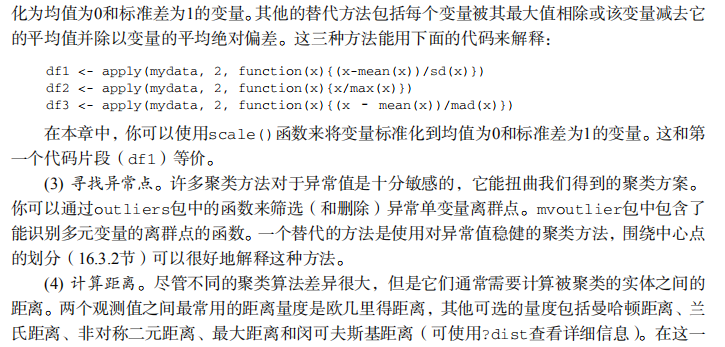
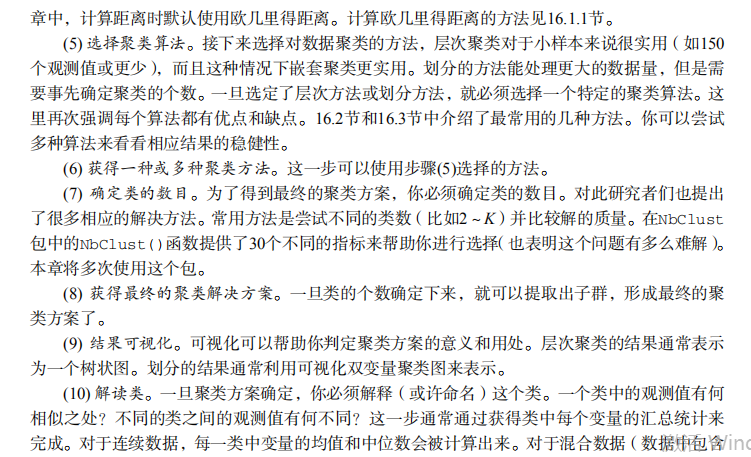
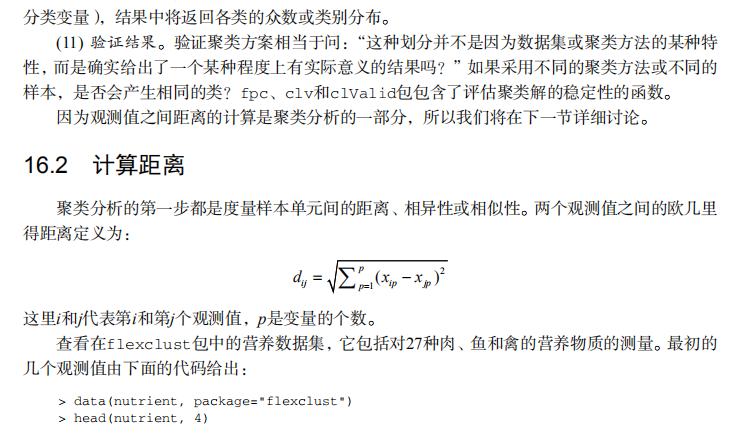
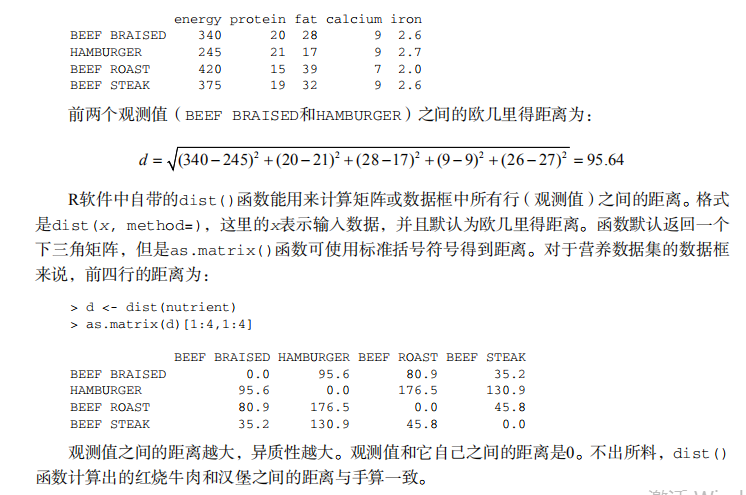
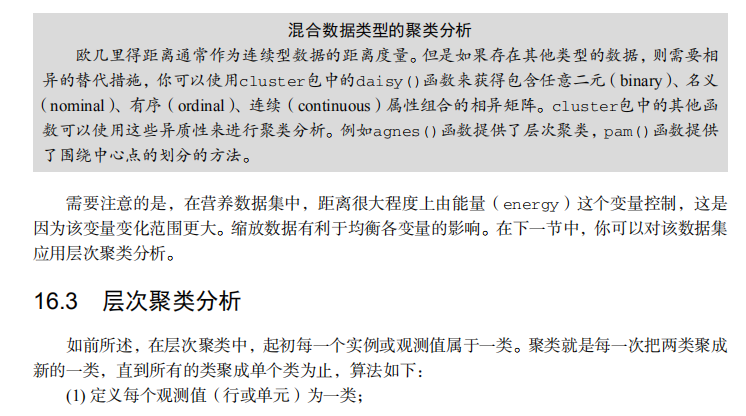
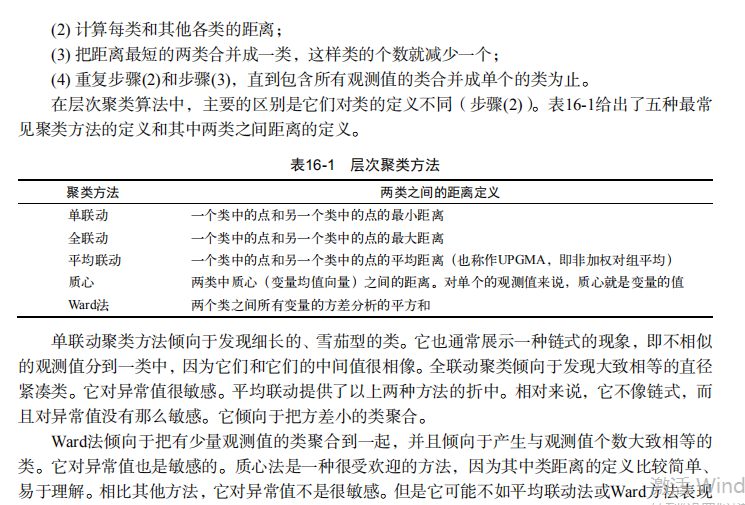
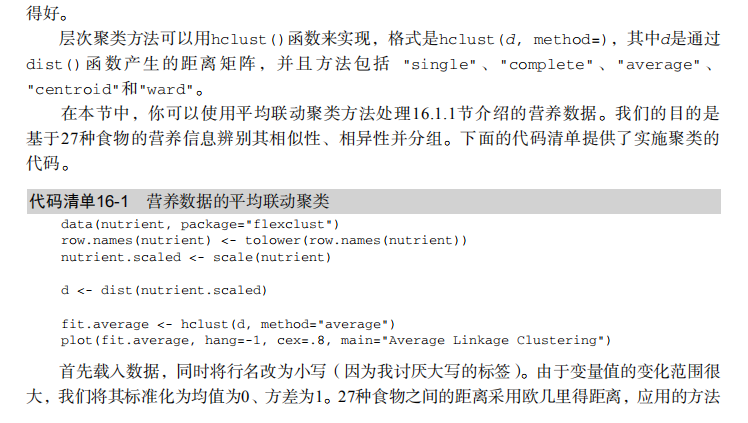
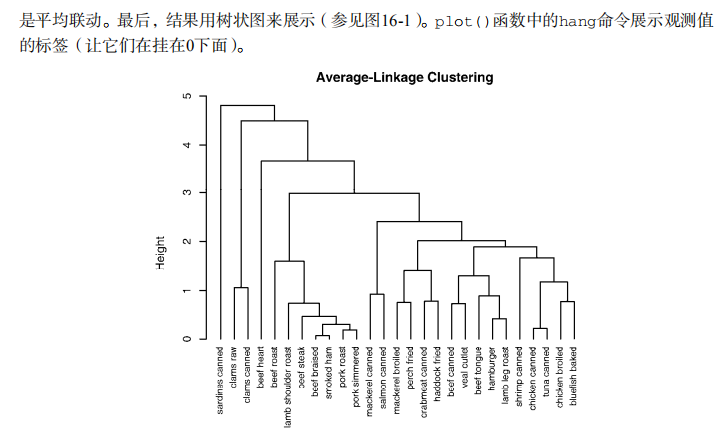
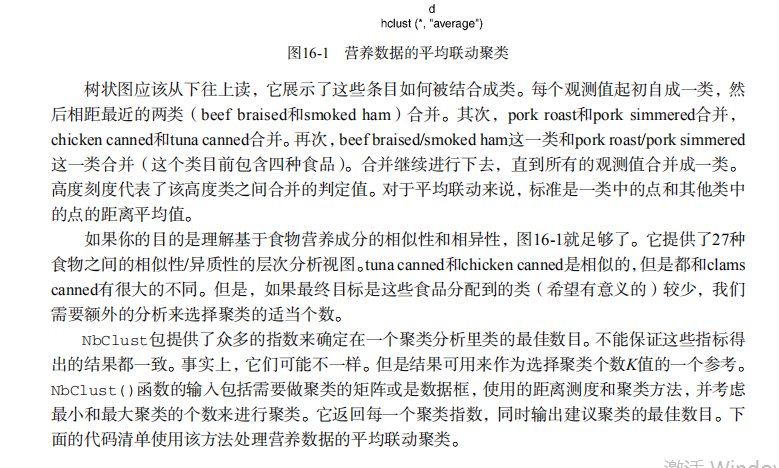
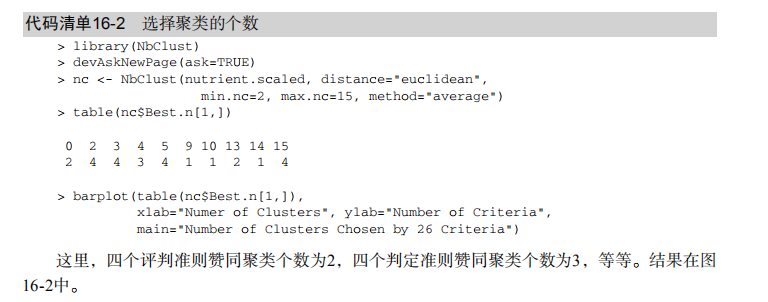
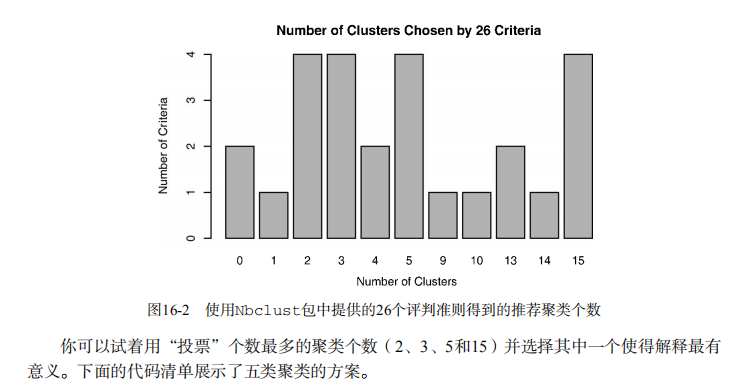

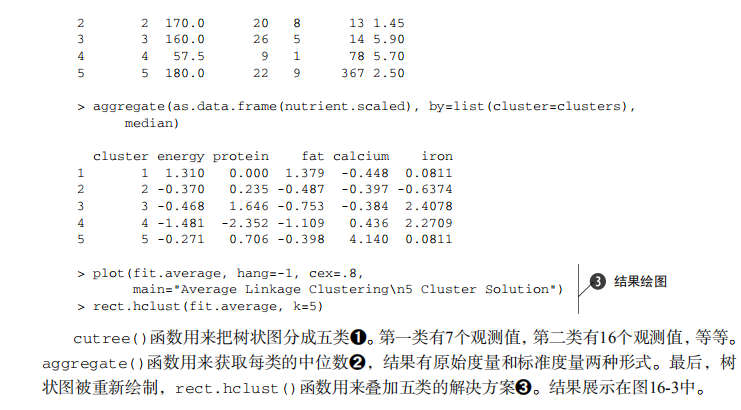
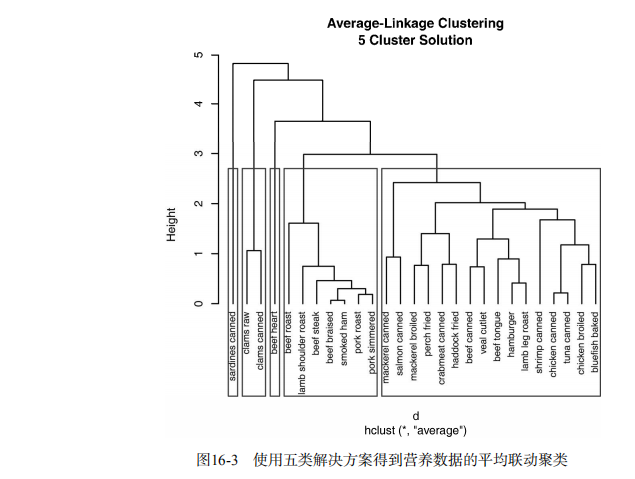

#-------------------------------------------------------#
# R in Action (2nd ed): Chapter 16 #
# Cluster analysis #
# requires packaged NbClust, flexclust, rattle #
# install.packages(c("NbClust", "flexclust", "rattle")) #
#-------------------------------------------------------# par(ask=TRUE)
opar <- par(no.readonly=FALSE) # Calculating Distances
data(nutrient, package="flexclust")
head(nutrient, 2)
d <- dist(nutrient)
as.matrix(d)[1:4,1:4] # Listing 16.1 - Average linkage clustering of nutrient data
data(nutrient, package="flexclust")
row.names(nutrient) <- tolower(row.names(nutrient))
nutrient.scaled <- scale(nutrient)
d <- dist(nutrient.scaled)
fit.average <- hclust(d, method="average")
plot(fit.average, hang=-1, cex=.8, main="Average Linkage Clustering") # Listing 16.2 - Selecting the number of clusters
library(NbClust)
nc <- NbClust(nutrient.scaled, distance="euclidean",
min.nc=2, max.nc=15, method="average")
par(opar)
table(nc$Best.n[1,])
barplot(table(nc$Best.n[1,]),
xlab="Numer of Clusters", ylab="Number of Criteria",
main="Number of Clusters Chosen by 26 Criteria") # Listing 16.3 - Obtaining the final cluster solution
clusters <- cutree(fit.average, k=5)
table(clusters)
aggregate(nutrient, by=list(cluster=clusters), median)
aggregate(as.data.frame(nutrient.scaled), by=list(cluster=clusters),
median)
plot(fit.average, hang=-1, cex=.8,
main="Average Linkage Clustering\n5 Cluster Solution")
rect.hclust(fit.average, k=5) # Plot function for within groups sum of squares by number of clusters
wssplot <- function(data, nc=15, seed=1234){
wss <- (nrow(data)-1)*sum(apply(data,2,var))
for (i in 2:nc){
set.seed(seed)
wss[i] <- sum(kmeans(data, centers=i)$withinss)}
plot(1:nc, wss, type="b", xlab="Number of Clusters",
ylab="Within groups sum of squares")} # Listing 16.4 - K-means clustering of wine data
data(wine, package="rattle")
head(wine)
df <- scale(wine[-1])
wssplot(df)
library(NbClust)
set.seed(1234)
nc <- NbClust(df, min.nc=2, max.nc=15, method="kmeans")
par(opar)
table(nc$Best.n[1,])
barplot(table(nc$Best.n[1,]),
xlab="Numer of Clusters", ylab="Number of Criteria",
main="Number of Clusters Chosen by 26 Criteria")
set.seed(1234)
fit.km <- kmeans(df, 3, nstart=25)
fit.km$size
fit.km$centers
aggregate(wine[-1], by=list(cluster=fit.km$cluster), mean) # evaluate clustering
ct.km <- table(wine$Type, fit.km$cluster)
ct.km
library(flexclust)
randIndex(ct.km) # Listing 16.5 - Partitioning around mediods for the wine data
library(cluster)
set.seed(1234)
fit.pam <- pam(wine[-1], k=3, stand=TRUE)
fit.pam$medoids
clusplot(fit.pam, main="Bivariate Cluster Plot") # evaluate clustering
ct.pam <- table(wine$Type, fit.pam$clustering)
ct.pam
randIndex(ct.pam) ## Avoiding non-existent clusters
library(fMultivar)
set.seed(1234)
df <- rnorm2d(1000, rho=.5)
df <- as.data.frame(df)
plot(df, main="Bivariate Normal Distribution with rho=0.5") wssplot(df)
library(NbClust)
nc <- NbClust(df, min.nc=2, max.nc=15, method="kmeans")
par(opar)
barplot(table(nc$Best.n[1,]),
xlab="Numer of Clusters", ylab="Number of Criteria",
main ="Number of Clusters Chosen by 26 Criteria") library(ggplot2)
library(cluster)
fit <- pam(df, k=2)
df$clustering <- factor(fit$clustering)
ggplot(data=df, aes(x=V1, y=V2, color=clustering, shape=clustering)) +
geom_point() + ggtitle("Clustering of Bivariate Normal Data") plot(nc$All.index[,4], type="o", ylab="CCC",
xlab="Number of clusters", col="blue")
吴裕雄--天生自然 R语言开发学习:聚类分析的更多相关文章
- 吴裕雄--天生自然 R语言开发学习:R语言的安装与配置
下载R语言和开发工具RStudio安装包 先安装R
- 吴裕雄--天生自然 R语言开发学习:数据集和数据结构
数据集的概念 数据集通常是由数据构成的一个矩形数组,行表示观测,列表示变量.表2-1提供了一个假想的病例数据集. 不同的行业对于数据集的行和列叫法不同.统计学家称它们为观测(observation)和 ...
- 吴裕雄--天生自然 R语言开发学习:导入数据
2.3.6 导入 SPSS 数据 IBM SPSS数据集可以通过foreign包中的函数read.spss()导入到R中,也可以使用Hmisc 包中的spss.get()函数.函数spss.get() ...
- 吴裕雄--天生自然 R语言开发学习:使用键盘、带分隔符的文本文件输入数据
R可从键盘.文本文件.Microsoft Excel和Access.流行的统计软件.特殊格 式的文件.多种关系型数据库管理系统.专业数据库.网站和在线服务中导入数据. 使用键盘了.有两种常见的方式:用 ...
- 吴裕雄--天生自然 R语言开发学习:R语言的简单介绍和使用
假设我们正在研究生理发育问 题,并收集了10名婴儿在出生后一年内的月龄和体重数据(见表1-).我们感兴趣的是体重的分 布及体重和月龄的关系. 可以使用函数c()以向量的形式输入月龄和体重数据,此函 数 ...
- 吴裕雄--天生自然 R语言开发学习:基础知识
1.基础数据结构 1.1 向量 # 创建向量a a <- c(1,2,3) print(a) 1.2 矩阵 #创建矩阵 mymat <- matrix(c(1:10), nrow=2, n ...
- 吴裕雄--天生自然 R语言开发学习:图形初阶(续二)
# ----------------------------------------------------# # R in Action (2nd ed): Chapter 3 # # Gettin ...
- 吴裕雄--天生自然 R语言开发学习:图形初阶(续一)
# ----------------------------------------------------# # R in Action (2nd ed): Chapter 3 # # Gettin ...
- 吴裕雄--天生自然 R语言开发学习:图形初阶
# ----------------------------------------------------# # R in Action (2nd ed): Chapter 3 # # Gettin ...
- 吴裕雄--天生自然 R语言开发学习:基本图形(续二)
#---------------------------------------------------------------# # R in Action (2nd ed): Chapter 6 ...
随机推荐
- 探讨 Git 代码托管平台的若干问题 - 2019 版
关于 Git 版本控制软件种类繁多,维基百科收录的最早的版本控制系统是 1972 年贝尔实验室开发的 Source Code Control System.1986 年 Concurrent Vers ...
- 中国文化产业基金越来越多,但IP变现难题为何仍未解决?
自始至终,中国商界领域的态势就有一个很明显的特征--哪里是风口.哪里是热点,企业就会蜂拥而至并集体掘金.一直到决出胜负,或者把整个风口"做烂"才罢休.很典型的案例就是电商领域已经呈 ...
- F - Fraction Formula Gym - 102307F
Mr. Potato Head has been promoted and now is a math professor at the UNAL. For his first course he i ...
- [原]C++新标准之std::chrono::time_point
原 总结 STL 标准库 chrono time_point ratio 概览 类定义 总结 思考 拓展 system_clock steady_clock high_resolution_cloc ...
- 使用XAMPP集成开发环境安装Apache、PHP的配置说明
一.安装XAMPP 双击安装包xamppinstaller.exe,可完成XAMPP的安装,与其他软件安装并无区别. 二.配置Apache端口,使用其可以正确启动 点击Start,启动Apache时可 ...
- mybatis学习笔记四
记录下动态sql的常用标签: 1.where 一般用作数据操作添加的条件 例子: <select id="selectByRoleId" resultMap="re ...
- [GX/GZOI2019]宝牌一大堆(DP)
出这种麻将题有意思吗? 乍看很难实则很水,就是麻将式DP,想必大家很熟悉了吧.首先把“国士无双”和“七对子”两种牌型判掉,然后观察牌胡的形式,发现每多一张牌实际上就是把1个面子变成1个杠子,然后可以直 ...
- Python_运维中常用的20个库和模块
1.psutil是一个跨平台库(https://github.com/giampaolo/psutil)能够实现获取系统运行的进程和系统利用率(内存,CPU,磁盘,网络等),主要用于系统监控,分析和系 ...
- Z变换解差分方程的思考
问题描述 今日碰到一道差分方程的题目,如下 [ y(n + 2) - cfrac{7}{10}y(n + 1) + cfrac{1}{10}y(n) = 7x(n+2) -2 x(n + 1) ] 已 ...
- SLAM——视觉里程计(一)feature
从现在开始下面两篇文章来介绍SLAM中的视觉里程计(Visual Odometry).这个是我们正式进入SLAM工程的第一步,而之前介绍的更多的是一些基础理论.视觉里程计完成的事情是视觉里程计VO的目 ...
